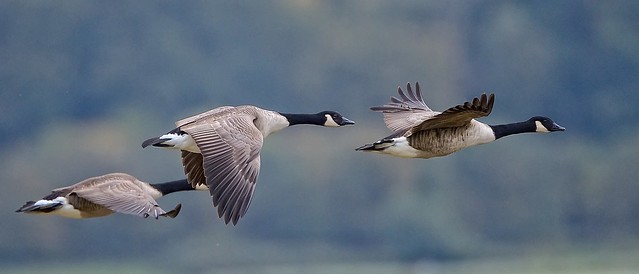They’re big and beautiful or they’re obnoxiously present. They are loud and contentious or they are pleasant and only nest protective. Whether positive or negative, it seems that just about everyone has strong feelings for the Canada goose. So we asked a couple of local bird experts to let us in on some interesting information about a bird once threatened, yet now prolific across North America.
Scott Menough of Wild Birds Unlimited spoke about a specific Canada goose pair that chose to nest immediately outside the radio station where he does his Saturday morning radio show, BirdTalk.
“They put up crime tape to protect the birds,” said Scott on a chuckle. “Imagine. The same people who cussed on the golf course about them, watched in fascination as the goslings grew.” And that pretty much sums up the problem. Canada geese are delightful to watch as their flocks fly across the sky in vee formations, or as they waddle around our lives, but the feces they leave at their favorite places make problems for people.
Research has found that the feces do not present a significant health threat, but when you consider that a single adult goose can leave as much as one pound of poo per day, golf courses and other open areas near water (great nesting spots) can develop—shall we say—a new kind of “hazard” for golfers. Apparently, Canada Geese are among the few species of birds able to digest grass, another reason they are so at home in our yards and on our golf courses. We provide comfortable, safe environments, so their populations grow.
 For Christine Goff, bestselling author of the Birdwatcher’s Mystery books, and Death Takes a Gander, Canada geese are a problem mostly because of their large numbers.
For Christine Goff, bestselling author of the Birdwatcher’s Mystery books, and Death Takes a Gander, Canada geese are a problem mostly because of their large numbers.
“The highline population alone,” said Christine about the front-range area of Colorado, “has as many as 180,000 geese.” Across the country populations of both the migratory and resident geese have grown to more than 5 million in a 2013 report by the U.S. Fish and Wildlife Service. And although annual round-ups and the humane capture and relocation of nuisance birds have been in practice for some time, the populations of these birds are a growing problem.
This wasn’t always the case. In the early 1900s the Canada goose migrating populations were dwindling fast. Hunters used resident populations with clipped wings as decoys to draw in the wild birds and then decimated the populations. At that point, the geese and other migratory birds were put under the protection of the Migratory Bird Treaty Act.
Then in the 1950’s a man named Gurney Crawford or “Father Goose” of Fort Collins became involved in repopulating Colorado with the birds. His efforts and the efforts of others like him helped create the successful resurgence we see today.
Some other things we suspect you may find interesting about these birds are:
- There are two distinct species beyond migratory and resident geese. The larger is the giant Canada goose who can grow to 45″ tall, according to Scott, while the smaller species, the cackling tops out at about 25″. “The interesting thing is that there are all sorts of sizes in between,” said Scott, “and there are several subspecies to each family of Canada geese.”
- “One of the hazards for these birds,” said Christine, “is that they will sometimes eat the lead weights fisher people forget behind after a day on the lake. The birds think the weights are the pebbles they are used to gobbling up to help digestion, but the lead poisons them.”
- The birds do a full molt of their feathers for about six weeks during the spring and early summer. During this process they cannot fly at all.
- Canada geese mate for life. Occasionally, geese will mate again if their first love is killed.
- The distinctive “honk” of the Canada goose is one of the most easily recognized birdcalls, even for those of us who are not birders.
So the next time someone says, “Look. Up in the sky. It’s a –” you may want to watch out for the Canada goose.
(Photo by Rivertay07)






Leave A Comment